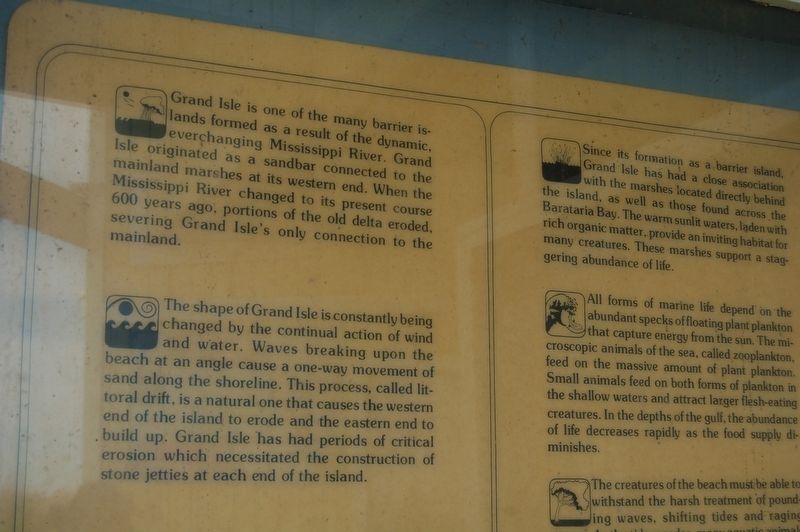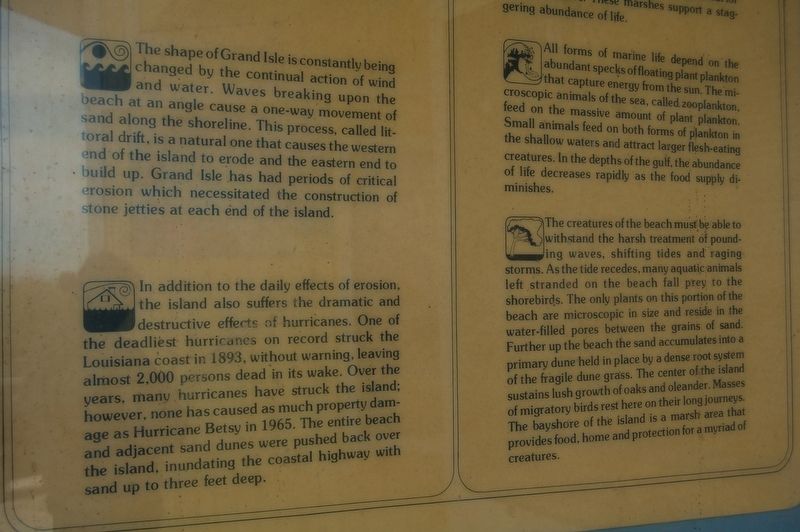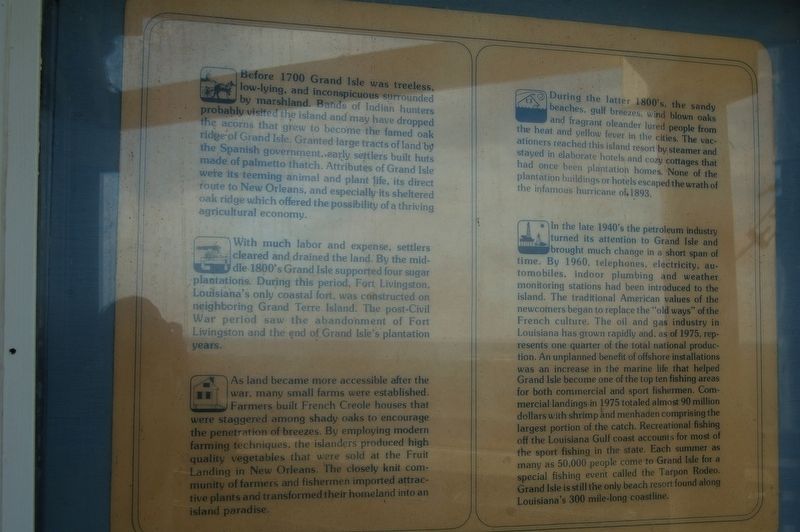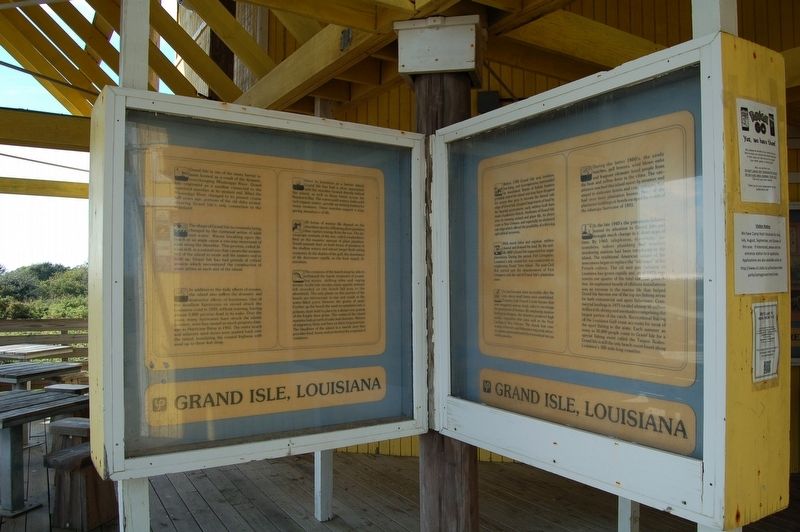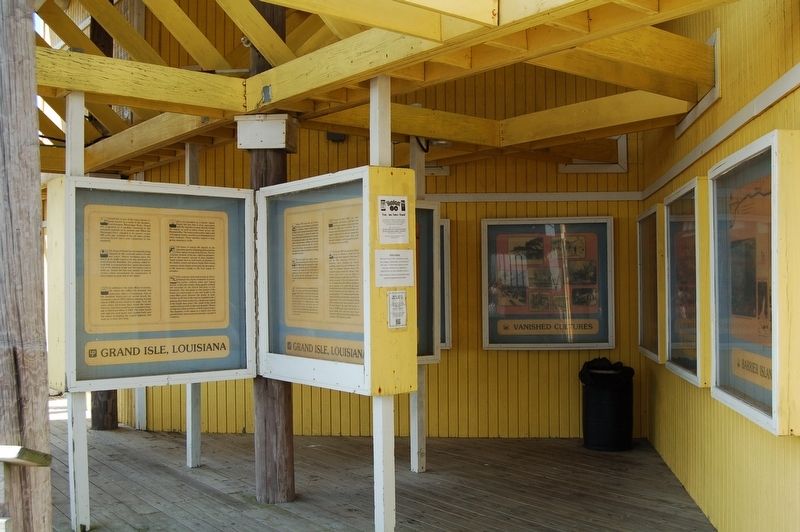Grand Isle, Louisiana
Grand Isle is one of the many barrier islands formed as a result of the dynamic, everchanging Mississippi River. Grand Isle originated as a sandbar connected to the mainland marshes at its western end. When the Mississippi River changed to its present course 600 years ago, portions of the old delta eroded, severing Grand Isle's only connection to the mainland.
The shape of Grand Isle is constantly being changed by the continual action of wind and water. Waves breaking upon the beach at an angle cause a one-way movement of sand along the shoreline. This process, called littoral drift, is a natural one that causes the western end of the island to erode and the eastern end to · build up. Grand Isle has had periods of critical erosion which necessitated the construction of stone jetties at each end of the island.
In addition to the daily effects of erosion, the island also suffers the dramatic and destructive effects of hurricanes. One of the deadliest hurricanes on record struck the Louisiana coast in 1893, without warning, leaving almost 2,000 persons dead in its wake. Over the years, many hurricanes have struck the island; however, none has caused as much property dam age as Hurricane Betsy in 1965. The entire beach and adjacent sand dunes were pushed back over the island, inundating the coastal highway
with sand up to three feet deep.Since its formation as a barrier island, Grand Isle has had a close association with the marshes located directly behind the island, as well as those found across the Barataria Bay. The warm sunlit waters, laden with rich organic matter, provide an inviting habitat for many creatures. These marshes support a staggering abundance of life.
All forms of marine life depend on the abundant specks of floating plant plankton that capture energy from the sun. The microscopic animals of the sea, called zooplankton, feed on the massive amount of plant plankton. Small animals feed on both forms of plankton in the shallow waters and attract larger flesh-eating creatures. In the depths of the gulf, the abundance of life decreases rapidly as the food supply diminishes.
The creatures of the beach must be able to withstand the harsh treatment of pounding waves, shifting tides and raging storms. As the tide recedes, many aquatic animals left stranded on the beach fall prey to the shorebirds. The only plants on this portion of the beach are microscopic in size and reside in the water-filled pores between the grains. of sand. Further up the beach the sand accumulates into a primary dune held in place by a dense root system of the fragile dune grass. The center of the island sustains lush growth of oaks and oleander. Masses of migratory birds rest here on their
long journeys. The bayshore of the island is a marsh area that provides food, home and protection for a myriad of creatures.Before 1700 Grand Isle was treeless, low-lying, and inconspicuous surrounded by marshland. Bands of Indian hunters probably visited the island and may have dropped the acorns that grew to become the famed oak ridge of Grand Isle. Granted large tracts of land by the Spanish government early settlers built huts made of palmetto thatch: Attributes of Grand Isle were' its teeming animal and plant life, its direct route to New Orleans, and especially its sheltered oak ridge which offered the possibility of a thriving agricultural economy.
With much labor and expense, settlers cleared and drained the land. By the middle 1800's Grand Isle supported four sugar plantations. During this period, Fort Livingston, Louisiana's only coastal fort, was constructed on neighboring Grand Terre Island. The post-Civil War period saw the abandonment of Fort Livingston and the end of Grand Isle's plantation years.
As land became more accessible after the war, many small farms were established. Farmers built French Creole houses that were staggered among shady oaks to encourage the penetration of breezes. By employing modern farming techniques, the islanders produced high quality vegetables that were sold at the Fruit Landing in New Orleans. The
closely knit community of farmers and fishermen imported attractive plants and transformed their homeland into an island paradise.During the latter 1800's, the sandy beaches, gulf breezes, wind blown oaks and fragrant oleander lured people from the heat and yellow fever in the cities. The vacationers reached this island resort by steamer and stayed in elaborate hotels and cozy cottages that had once been plantation homes. None of the plantation buildings or hotels escaped the wrath of the infamous hurricane of 1893.
In the late 1940's the petroleum industry turned its attention to Grand Isle and brought much change in a short span of time. By 1960, telephones, electricity, automobiles, indoor plumbing and weather monitoring stations had been introduced to the island. The traditional American values of the newcomers began to replace the "old ways" of the French culture. The oil and gas industry in Louisiana has grown rapidly and, as of 1975, represents one quarter of the total national production. An unplanned benefit of offshore installations was an increase in the marine life that helped Grand Isle become one of the top ten fishing areas for both commercial and sport fishermen. Commercial landings in 1975 totaled almost 90 million dollars with shrimp and menhaden comprising the largest portion of the catch. Recreational fishing off the Louisiana Gulf coast accounts for most
of the sport fishing in the state. Each summer as many as 50,000 people come to Grand Isle for a. special fishing event called the Tarpon Rodeo. Grand Isle is still the only beach resort found along Louisiana's 300 mile-long coastline.Topics. This historical marker is listed in these topic lists: Environment • Settlements & Settlers.
Location. 29° 15.652′ N, 89° 57.109′ W. Marker is in Grand Isle, Louisiana, in Jefferson Parish. Marker can be reached from Admiral Craik Drive near State Highway 1. Touch for map. Marker is at or near this postal address: 108 Admiral Craik Drive, Grand Isle LA 70358, United States of America. Touch for directions.
Other nearby markers. At least 6 other markers are within 10 miles of this marker, measured as the crow flies. 32 - Pounder (approx. 2 miles away); Fort Livingston (approx. 2 miles away); a different marker also named Grand Isle (approx. 2 miles away); a different marker also named Grand Isle (approx. 2 miles away); Cheniere Caminada Cemetery (approx. 7˝ miles away); Parish of Jefferson (approx. 9.2 miles away).
More about this marker. Located inside the Grand Isle State Park. There is admission to park. Marker is located on the walkway leading up to the pier.
Credits. This page was last revised on March 25, 2018. It was originally submitted on March 25, 2018, by Cajun Scrambler of Assumption, Louisiana. This page has been viewed 447 times since then and 43 times this year. Photos: 1, 2, 3, 4, 5. submitted on March 25, 2018.
